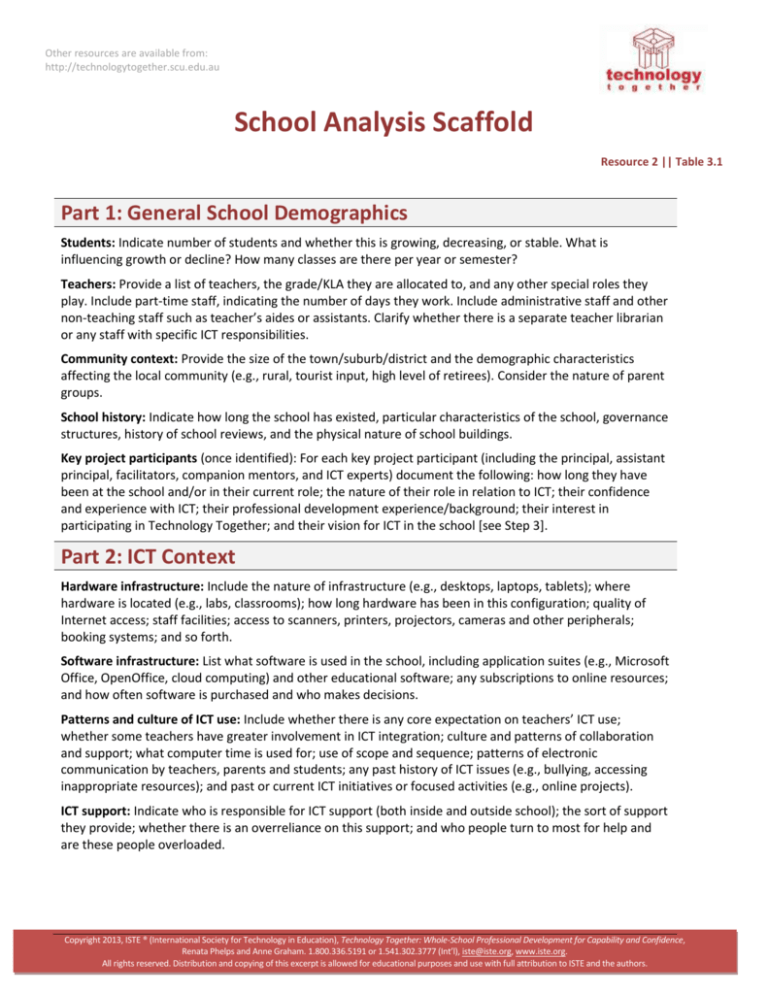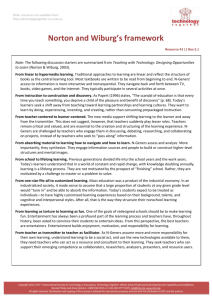
Other resources are available from:
http://technologytogether.scu.edu.au
School Analysis Scaffold
Resource 2 || Table 3.1
Part 1: General School Demographics
Students: Indicate number of students and whether this is growing, decreasing, or stable. What is
influencing growth or decline? How many classes are there per year or semester?
Teachers: Provide a list of teachers, the grade/KLA they are allocated to, and any other special roles they
play. Include part-time staff, indicating the number of days they work. Include administrative staff and other
non-teaching staff such as teacher’s aides or assistants. Clarify whether there is a separate teacher librarian
or any staff with specific ICT responsibilities.
Community context: Provide the size of the town/suburb/district and the demographic characteristics
affecting the local community (e.g., rural, tourist input, high level of retirees). Consider the nature of parent
groups.
School history: Indicate how long the school has existed, particular characteristics of the school, governance
structures, history of school reviews, and the physical nature of school buildings.
Key project participants (once identified): For each key project participant (including the principal, assistant
principal, facilitators, companion mentors, and ICT experts) document the following: how long they have
been at the school and/or in their current role; the nature of their role in relation to ICT; their confidence
and experience with ICT; their professional development experience/background; their interest in
participating in Technology Together; and their vision for ICT in the school [see Step 3].
Part 2: ICT Context
Hardware infrastructure: Include the nature of infrastructure (e.g., desktops, laptops, tablets); where
hardware is located (e.g., labs, classrooms); how long hardware has been in this configuration; quality of
Internet access; staff facilities; access to scanners, printers, projectors, cameras and other peripherals;
booking systems; and so forth.
Software infrastructure: List what software is used in the school, including application suites (e.g., Microsoft
Office, OpenOffice, cloud computing) and other educational software; any subscriptions to online resources;
and how often software is purchased and who makes decisions.
Patterns and culture of ICT use: Include whether there is any core expectation on teachers’ ICT use;
whether some teachers have greater involvement in ICT integration; culture and patterns of collaboration
and support; what computer time is used for; use of scope and sequence; patterns of electronic
communication by teachers, parents and students; any past history of ICT issues (e.g., bullying, accessing
inappropriate resources); and past or current ICT initiatives or focused activities (e.g., online projects).
ICT support: Indicate who is responsible for ICT support (both inside and outside school); the sort of support
they provide; whether there is an overreliance on this support; and who people turn to most for help and
are these people overloaded.
Copyright 2013, ISTE ® (International Society for Technology in Education), Technology Together: Whole-School Professional Development for Capability and Confidence,
Renata Phelps and Anne Graham. 1.800.336.5191 or 1.541.302.3777 (Int’l), iste@iste.org, www.iste.org.
All rights reserved. Distribution and copying of this excerpt is allowed for educational purposes and use with full attribution to ISTE and the authors.
Other resources are available from:
http://technologytogether.scu.edu.au
History of ICT professional development: Include the types of professional development undertaken by
individuals (past and present); any professional development undertaken by the whole school; what has
worked and what has not and why; and the level of support, interaction, sharing, and discussion between
staff.
Future agendas: Indicate whether the school has an ICT vision; whether the school has any specific priorities
or goals in relation to ICT; whether there are immediate perceived issues or staff development needs; and
how to foster ownership of any school-wide initiatives.
Part 3: School Culture
Teacher culture: Include whether the school has a relaxed or formal atmosphere; reaction of staff to visitors
or outsiders (e.g., whether hesitant, welcoming); teachers’ relationships with students; teachers’
relationships with each other and social networks; general level of motivation and receptivity to ICT learning
and change; and the attitude of staff toward engaging with educational theory.
Pedagogical culture: Indicate classroom arrangement and management style, for example, how classrooms
are arranged or the balance of collaborative versus individual learning; balance of constructivist and
directive-style teaching approach; other teaching approaches in use, for example, Bloom’s Taxonomy or
Gardner’s multiple intelligences; and the degree of risk taking and experimentation with teaching methods.
Culture of learning and openness to change: Indicate the attitude toward learning amongst staff; teachers’
approaches to trying new things; who are seen as leaders; who are seen as change agents; cultures of
collaboration; and any history of mentoring.
Culture of meetings and discussion: Indicate the frequency and nature of school meetings; what is covered
at meetings; level of engagement and commitment to meeting agendas; potential for integrating
Technology Together discussion; receptivity to collegial discussion; and receptivity to reflection.
Part 4: School and ICT Leadership
Leadership and management: Include who the main ICT leaders in the school are; what management
structures are in place (e.g., IT committee); the level of input classroom teachers have in the school’s ICT
decisions; and whether teachers feel that they can take risks with what they try in their classrooms.
Financial issues: Indicate how finances are managed in relation to technology; how hardware and software
is purchased; and whether there is a plan for replacement.
Policy: Include what ICT related policies or other related documents are in place; what policies have been in
place in the past; what new policies might be needed; and who might be involved in policy development and
review.
Vision: Ask does the school have an ICT vision? Is this a shared vision? How can ownership of any schoolwide initiatives be fostered?
Copyright 2013, ISTE ® (International Society for Technology in Education), Technology Together: Whole-School Professional Development for Capability and Confidence,
Renata Phelps and Anne Graham. 1.800.336.5191 or 1.541.302.3777 (Int’l), iste@iste.org, www.iste.org.
All rights reserved. Distribution and copying of this excerpt is allowed for educational purposes and use with full attribution to ISTE and the authors.
Other resources are available from:
http://technologytogether.scu.edu.au
Part 5: Students’ technology use
Teachers’ perceptions of students’ knowledge and skills: Include the types of ICT activities students are
currently performing in classrooms; what ICT activities students have done in past; teachers’ perceptions of
students’ ICT abilities; and how much teachers know about students’ recreational use of technology.
Student’s perspectives and vision: Schools can consider to what degree they will involve students in the
school analysis. This could vary from a simple survey on home computer access and use to a much deeper
engagement around what they like about technology use in the school, what they do not like, and what
suggestions and visions they have for change (see Resource 3 | Form 3.1 and other student surveys in
Appendix B, and on the Technology Together website).
Part 6: Teachers’ values, attitudes, beliefs and skills
See the teacher survey in Appendix B or on the Technology Together website.
Copyright 2013, ISTE ® (International Society for Technology in Education), Technology Together: Whole-School Professional Development for Capability and Confidence,
Renata Phelps and Anne Graham. 1.800.336.5191 or 1.541.302.3777 (Int’l), iste@iste.org, www.iste.org.
All rights reserved. Distribution and copying of this excerpt is allowed for educational purposes and use with full attribution to ISTE and the authors.






